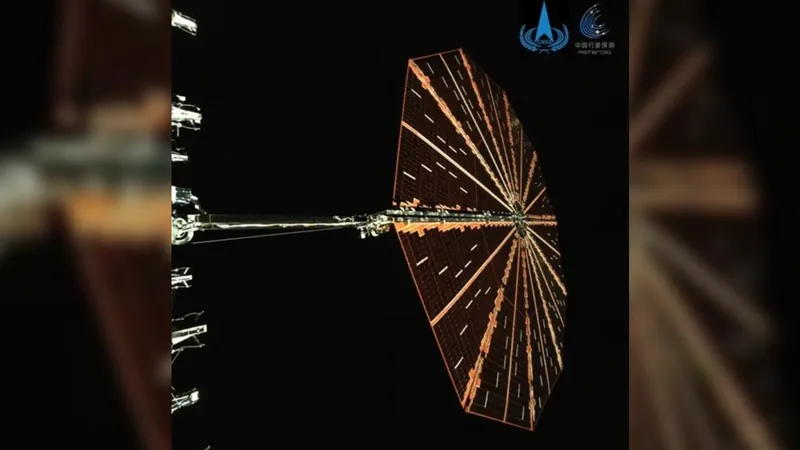
China Unveils First Image of Its Secretive 'Quasi Moon' Probe After Stealth Launch
2025-06-10
Author: Ling
In a stunning reveal, Chinese authorities have disclosed the first-ever image of the intriguing Tianwen 2 spacecraft, just two weeks after its covert launch into the cosmos. This enigmatic probe, resembling a current NASA craft, is set to embark on a groundbreaking mission to gather samples from one of Earth's elusive "quasi-moons" next year.
Launched on May 29, the Tianwen 2 ascended into the night sky aboard a Long March 3B rocket, departing from the Xichang spaceport in southwestern China at approximately 1:31 a.m. local time. The mission has been shrouded in secrecy, with the China National Space Administration (CNSA) announcing the successful liftoff only an hour after it occurred.
Scheduled for a close encounter with the asteroid 2016 HO3, known as Kamo'oalewa, in July 2026, the Tianwen 2 aims to land on this Ferris wheel-sized space rock and collect valuable samples to return to Earth. Kamo'oalewa, meaning "oscillating celestial object" in Hawaiian, is classified as a quasi-satellite—one that orbits the sun in tandem with Earth, circling our planet without being gravitationally tethered.
Until recently, the only insights into the probe's appearance were rudimentary artistic renderings. However, on June 6, CNSA surprised the world by announcing that the spacecraft is functioning perfectly and is currently about 1.9 million miles (3 million kilometers) from Earth—eight times farther than our moon. Accompanying this update was a stunning image of one of its 10-sided solar panels, reaching gracefully into the depths of space.
The design of Tianwen 2 appears similar to NASA's Lucy mission spacecraft, also featuring decagonal solar panels and currently en route to the Trojan asteroids near Jupiter. In contrast, the previous Tianwen 1 spacecraft, which transported China's Zhurong Mars rover to the Red Planet in 2021, utilized rectangular solar panels.
If the Tianwen 2 successfully lands on Kamo'oalewa and procures the desired samples, it plans to return to Earth with asteroid fragments during a close pass in late 2027. Scientists are hopeful that these samples can be retrieved from a return module, akin to the OSIRIS-REx mission's successful sample return in September 2023.
Following this primary mission, the spacecraft will embark on a secondary objective—visiting the hybrid comet-asteroid 311P/PanSTARRS, located in the asteroid belt between Mars and Jupiter, with an anticipated arrival around 2035.
What Are Quasi-Moons?
Kamo'oalewa, measuring between 130 and 330 feet (40 to 100 meters) in width, maintains a minimum distance of about 2.9 million miles (4.6 million kilometers) from Earth and completes an orbit around our planet roughly every 45 years. Scientists theorize that it is an ancient fragment of Earth’s moon, possibly ejected during a meteor strike millions of years ago. Earth is home to six other quasi-moons, which, like Kamo'oalewa, orbit the sun alongside our planet but lack a permanent connection to it. These intriguing rocks, often nicknamed "minimoons," temporarily orbit closer to Earth for short spans of time, generally less than a year.
An example of such a minimoon was the asteroid 2024 PT5, discovered in September 2024, which traversed around Earth for approximately three months before departing.



 Brasil (PT)
Brasil (PT)
 Canada (EN)
Canada (EN)
 Chile (ES)
Chile (ES)
 Česko (CS)
Česko (CS)
 대한민국 (KO)
대한민국 (KO)
 España (ES)
España (ES)
 France (FR)
France (FR)
 Hong Kong (EN)
Hong Kong (EN)
 Italia (IT)
Italia (IT)
 日本 (JA)
日本 (JA)
 Magyarország (HU)
Magyarország (HU)
 Norge (NO)
Norge (NO)
 Polska (PL)
Polska (PL)
 Schweiz (DE)
Schweiz (DE)
 Singapore (EN)
Singapore (EN)
 Sverige (SV)
Sverige (SV)
 Suomi (FI)
Suomi (FI)
 Türkiye (TR)
Türkiye (TR)
 الإمارات العربية المتحدة (AR)
الإمارات العربية المتحدة (AR)